Best Bike Locks of 2024: Heavy-duty Chain, Folding, and U-Locks to Keep Your Bike Safe
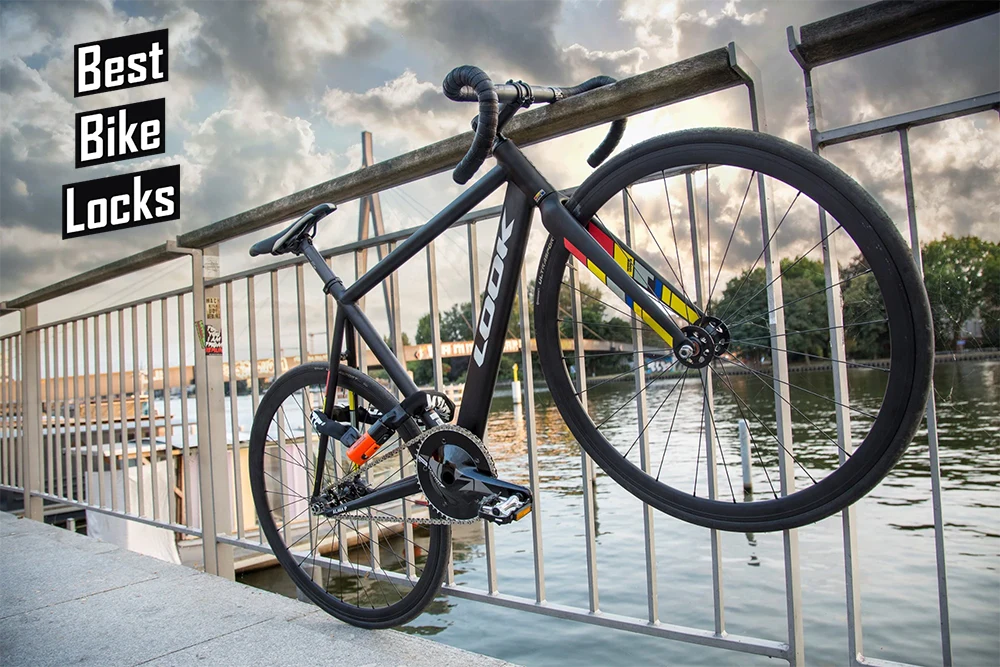
Bike theft is an unfortunate reality that many cyclists have to face at some point. Unless you only use your bike for short rides and never stop at shops or restaurants, you will inevitably need a bike lock at some point.
Naturally, more valuable bikes are at higher risk and some should never be left chained up in public. Many competitive cyclists even use a cheaper secondary bike for general commuting around town and keep their expensive bikes safely at home.
Whatever the case for you, remember to always lock your bike to a stationary object that cannot be cut or easily removed. Always place the lock facing the ground when possible, and avoid leaving your expensive ride in dark alleys!
Below, we’ll show you the highest-rated and most secure bike locks on the market and share some valuable pieces of advice on how to best protect your cherished two-wheeler!
Best Bike Chain Locks
Chain locks are considered to be most effective against bike thieves. This type of lock might not be as convenient to carry around, but they do a great job protecting the bicycle against bolt cutters. Chain locks vary from thinner 11mm chain links which are easier to cut to thick 16mm links that require tough bolt cutters to break.
The advantage of chain locks is that they can usually be wrapped around large objects and can lock up multiple bikes at once. If you often find you need to tie your bike to thick trees or lamp posts, a chain lock might be the answer. As chain locks are generally longer, you can easily lock the bike and one wheel with it.
However, the strongest chain locks are very heavy and can add considerable weight to your bike.
Hiplok Gold
Best Wearable Chain Lock
MSRP: $130 – $140
- Security Ratings: Sold Secure Gold
- Weight: 5 lbs. 4.7 oz.
- Keys: 3 replaceable keys
- Thickness: 10mm chain thickness
- Size: 33.5″ length
Hiplok Gold is a heavy-duty wearable chain lock that will keep most bike thieves away.
It’s best suited for commuters who regularly carry their lock and lock their bike as the Hiplok Gold can be comfortably used around the hips while cycling. It adjusts to fit comfortably on waists measuring 24 to 44 in.
The Hiplok Gold also has a protective sleeve that prevents the bike’s frame from getting scratched and adds a little cushion when you’re carrying the lock around your waist like a belt. The protective sleeve is also reflective, so it will make you more visible at night.
Finally, this lock comes with three replaceable keys, has a Sold Secure Gold rating, and boasts a 12mm lock thickness for utmost anti-theft protection.
Kryptonite New York Chain 1210
Thickest Bike Chain Lock
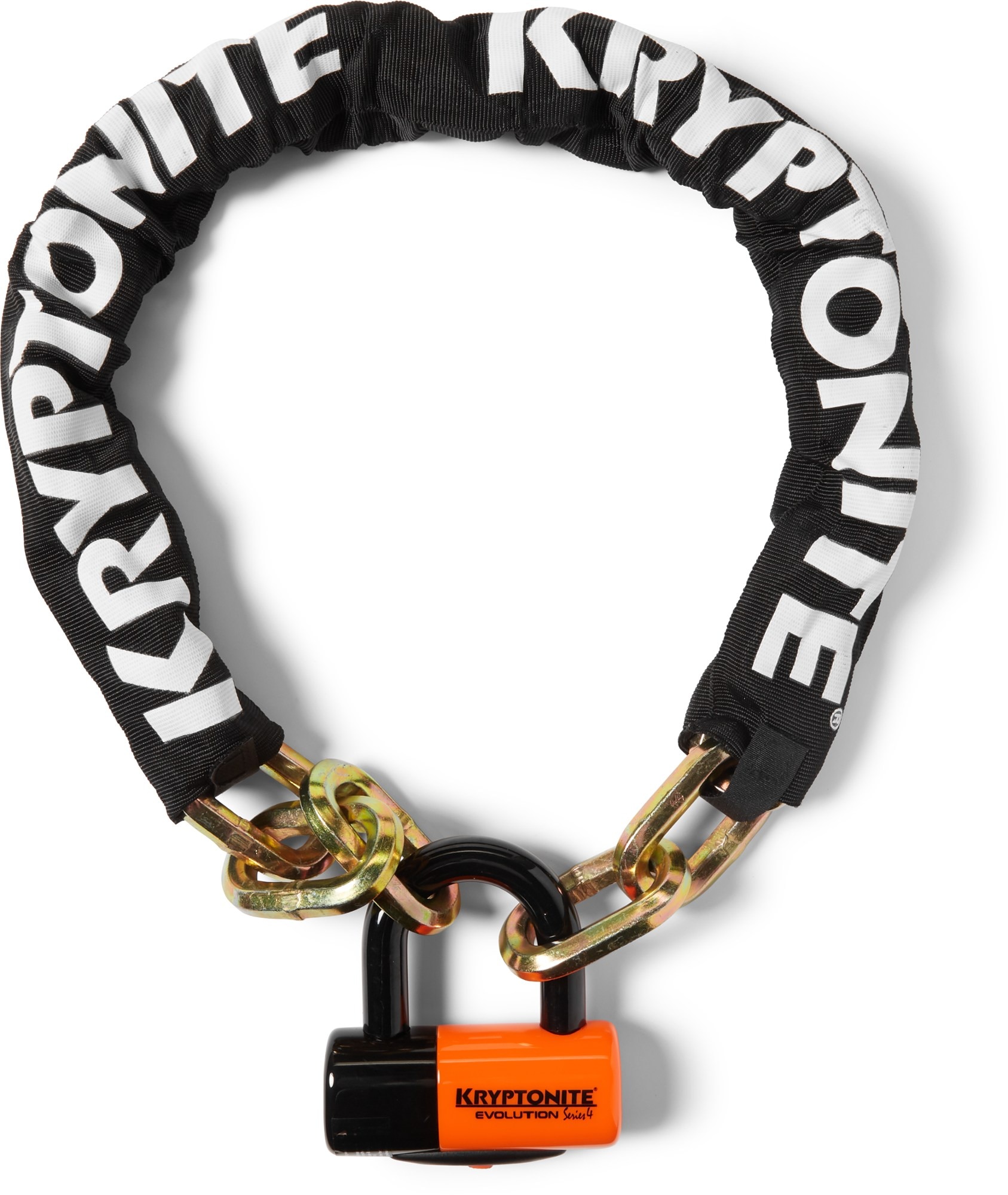
MSRP: $153.95
- Security Ratings: Sold Secure Gold; Kryptonite 9/10
- Weight: 8 lbs. 9 oz.
- Keys: 3 replaceable keys
- Thickness: 12mm chain thickness
- Size: 40″ length
Inspired by the streets of New York, the Kryptonite 1210 is a robust chain lock made by one of the most trusted bike lock brands out there.
The biggest advantage of this lock is the length of the chain (40″) which can be wrapped around any object, including lamp posts. There’s also plenty of room to lock either wheel together with the frame. The only disadvantage is the 8 lbs. 9 oz. weight, so you’ll need to wrap it around your bike or carry it in a backpack.
The Kryptonite 1210 boasts a 12mm thick chain and a 14mm thick shackle, both of which will present a challenge for most cutting tools out there.
It comes with 3 replaceable keys, a Sold Secure Gold rating, and it’s also rated 9/10 by Kryptonite.
This is the best chain lock if you want heavy-duty protection against the toughest attacks that you can use on the go or in your garage.
Abus Granit CityChain X-Plus 1060
Longest Bike Chain Lock
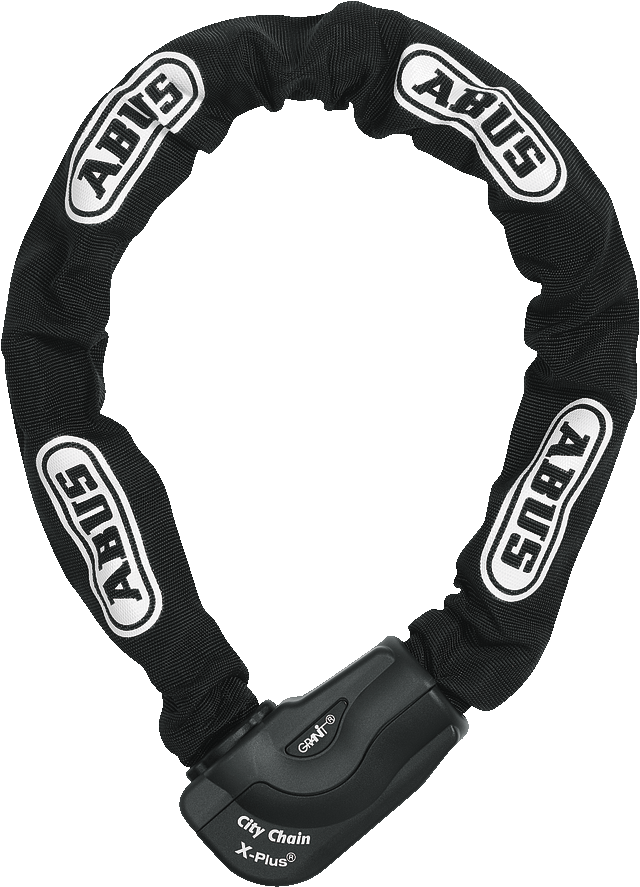
MSRP: $210
- Security Ratings: Sold Secure Gold; ART 3/5
- Weight: 4 lbs. 10 oz.
- Keys: 2 replaceable keys
- Thickness: 10mm chain thickness
- Size: 43.2″ length
The Abus Granit City Lock X-Plus 1060’s name is as long as its chain, so it’s perfect for commuters who need to ensure they can always find a spot to lock their bikes. With a 43.2″ chain length, you can always find a safe place to leave your bike.
The soft sleeve around the metal chain will not scrape against the frame in case you were planning to wrap it around the bike when commuting.
The City Lock X-Plus 1060 is bulky and heavy, but not as heavy as some other options on this list. The 4 lbs. 10 oz. is determined by a 10mm thick chain and a bulky shackle that will repel most attacks.
This lock boasts a Gold level of Sold Secure rating and Abus’s 15/15 rating, plus it comes with two replaceable keys in case you lose any.
Kryptonite Keeper 712 Chain Lock
Best Combination Chain Lock

MSRP: $65.95
- Security Ratings: Sold Secure Bronze; Kryptonite 5/10
- Weight: 4.5 lbs
- Keys: Keyless
- Thickness: 7mm chain thickness
- Size: 47.3″ length
This bike lock is a great alternative for those who wish to commute keyless. The Kryptonite Keeper 712 offers a considerable amount of safety in low to moderate theft-risk neighborhoods.
The concept of this lock makes it unappealing for bolt-cutters or any other tool besides the angle grinder, which also needs quite a bit of time and effort to go through the 7mm thick links.
This is a great choice for those who are better at remembering the passcodes than keeping small keys from getting lost.
However, keep in mind that the Kryptonite Keeper 712 is not as highly rated as some other options on this list, so it’s best not to use it in high-risk areas for prolonged periods.
Best Bike U-Locks
U-locks, also known as D-locks, are the strongest and safest locks available as they are almost impossible to break, even with industrial tools.
However, you should avoid buying cheap U-locks as these are made from weak materials and are easy to pick. U-locks come in varying sizes and thicknesses and should include an independent rating from a security testing company like Sold Secure or ART.
The downside to U-locks is that they only fit around an object smaller than the size of the lock, so you may have to search long to find a suitable place to park. They can also be difficult to carry on the bike and often take up space in the frame where water bottles or frame bags could fit.
The best U-locks are made by Kryptonite, ABUS, and Serfa. If you live in a high-risk area like a busy city, always use a U-lock in combination with a steel cable to secure your wheels.
Abus Granit X-Plus 540 U-Lock
Tough High-Protection U-Lock
MSRP: $160
- Security Ratings: Sold Secure Diamond; ART 3/5
- Weight: 3 lbs. 7.7 oz.
- Keys: 2 keys
- Thickness: 13mm shackle
- Size: 9 inches
The Abus Granit X-Plus 540 U-Lock is equipped with a patented power-cell technology that offers protection against hitting and pulling attacks.
When locking a bicycle with this high-protection u-lock, make sure the lock is snug around the bike so it won’t leave room for thieves to mess around with it!
The Granit X-Plus 540 U-lock comes with a 13mm wide hardened square shaft parabolic shackle that’s extremely resistant to attacks, and the X-Plus key cylinder offers protection from picking.
The lock itself is 9 inches long, which offers lots of options for using it. The best one, however, is to lock it around your seat tube and rear wheel.
With a Sold Secure Diamond rating, you can have peace of mind leaving your bike unattended.
Kryptonite Messenger Mini Plus U-Lock
Best Protection for Frame and Wheel
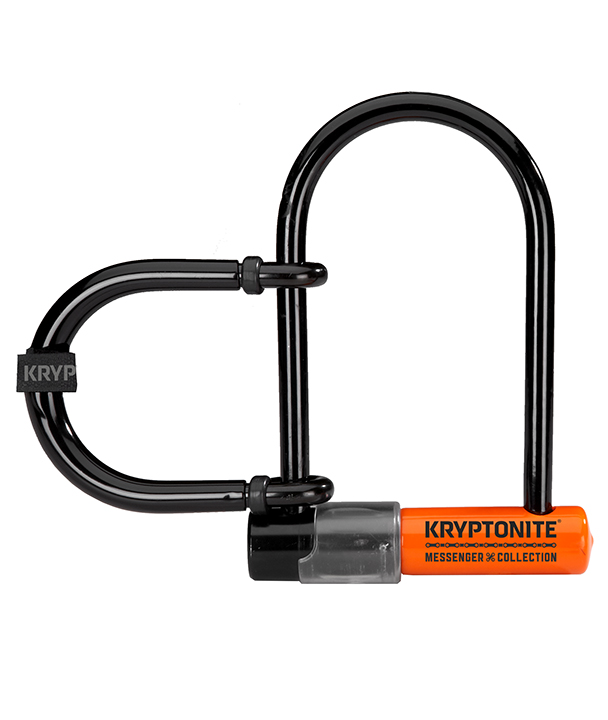
MSRP: $103.95
- Security Ratings: Sold Secure Silver; ART 2/5
- Weight: 2 lbs. 8.2 oz.
- Keys: 2 keys
- Thickness: 11mm lock thickness
- Size: 6.5 x 3.75 inches
The Kryptonite Messenger Mini+ is designed for NYC bike messengers who are locking and unlocking their bikes to different objects multiple times per day.
The extra shackle is meant to lock the rear wheel to the frame, so your entire bike is safe from theft. But you should keep in mind not to use the additional shackle as the main point of locking, as it’s not as strong as the main U-lock shackle!
The lock is 11mm in diameter, comes with 2 keys, and boasts a double-deadbolt design that prevents thieves from cutting one side of the shackle and just spinning it open. They need to cut both sides, which doubles the protection.
With a Sold Secure Silver and ART 2/5-star rating, the Kryptonite Messenger Mini+ is not the toughest U-lock out there, but it’s perfect for quick stops in high-risk areas.
Kryptonite New-U New York Lock
Thickest Bike U-Lock
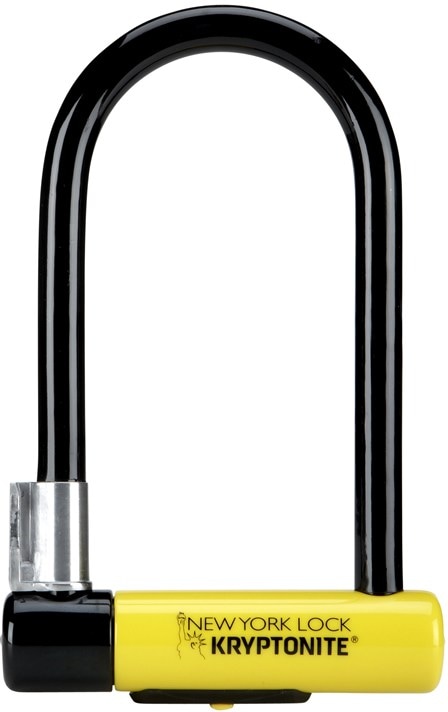
MSRP: $147.95
- Security Ratings: Sold Secure Gold; ART 4/5
- Weight: 4 lbs. 7.2 oz.
- Keys: 3 keys
- Thickness: 16mm lock thickness
- Size: 8″ x 4″
This is another NYC-inspired U-lock made by Kryptonite that lets you leave the bike on the street without constantly thinking if it is still there or not. It is among the safest options you could choose, which is reflected in its Sold Secure Gold and ART 4/5-star rating.
The New-U New York Lock comes with a 16mm wide shackle, which is one of the widest and toughest you can get. It resists bolt cutters and leverage attacks and the protective coating won’t damage your bike’s paint job.
It also features a double deadbolt design that protects against cut and twist attacks—to get the lock off, thieves will have to make two cuts, which takes double the time.
The package also includes three keys, one of which has an LED light, and a mounting bracket that lets you easily carry this U-lock on your bike.
Abus Ultra 410 U-Lock + Cobra 10 Cable
Best U-Lock and Cable Combo
MSRP: $60
- Security Ratings: Sold Secure Silver; Abus 8/15
- Weight: 2 lbs. 5.4 oz.
- Keys: 2 keys
- Thickness: 12mm round shackle
- Size: 9″ x 4″
The Abus Ultra 410 is a simple, tough U-lock with a Cobra 10 cable included making it convenient to use when you’d like to lock both the frame and one of the wheels or the saddle.
The U-lock is 9″ x 4″ in size, which is pretty standard and lets you easily lock your frame to most types of bike parking infrastructure. The added cable is tough and makes it easy to lock the wheels.
The 12mm thick round shackle has a soft coating that will protect your bike’s finish from getting scratched up.
The body is made from the same material as the hardened steel shackle, so they are cut and torsion-resistant. Plus, lock uses a double-bolting mechanism, which means it’s also resistant to cut and twist attacks.
Get it if you want a relatively lightweight and simple-looking lock that offers tons of hidden protection.
Kryptonite KryptoLock Standard U-lock with cable
Best Choice for Complete Security
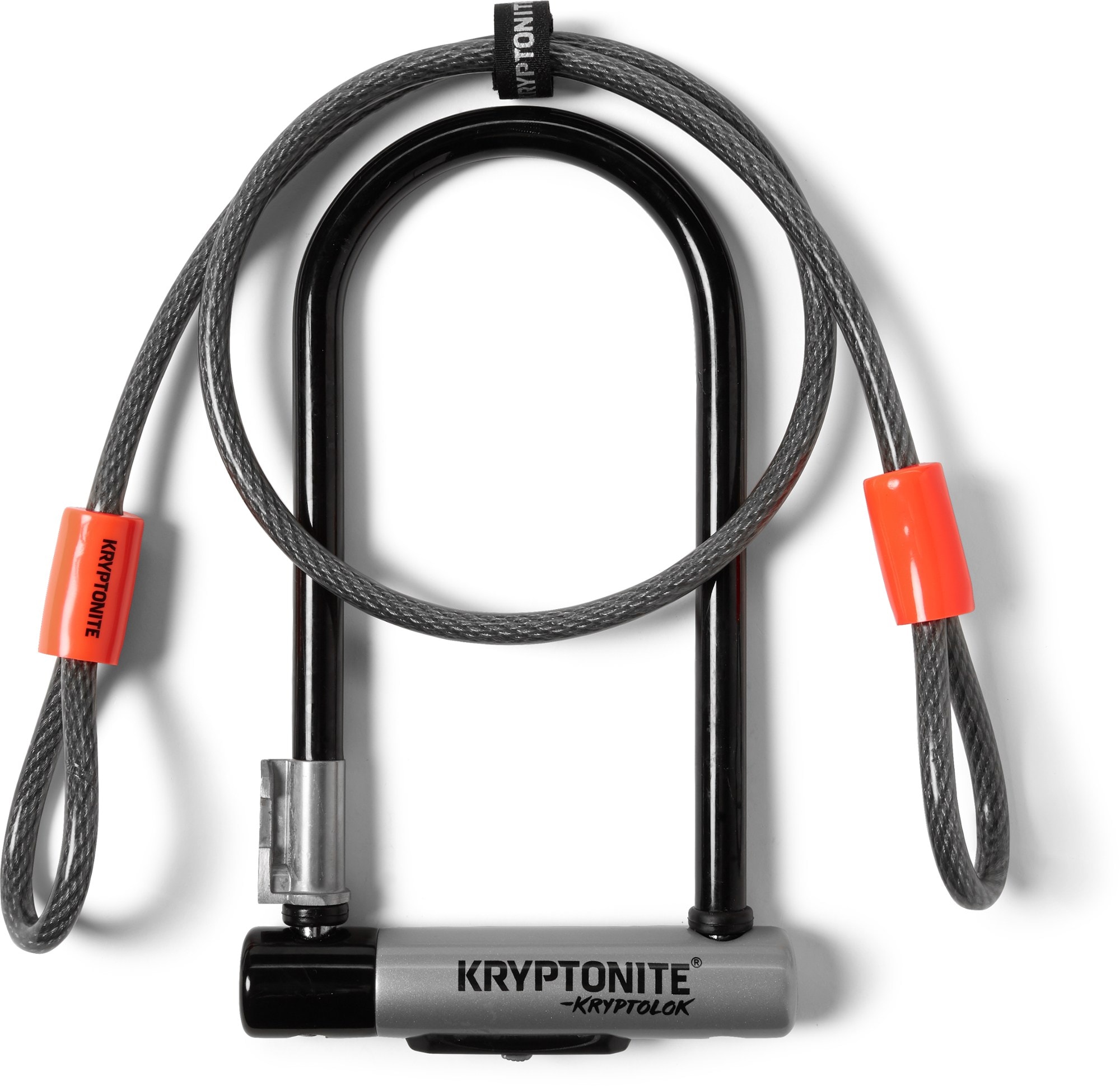
MSRP: $70.95
- Security Ratings: Sold Secure Gold; ART 2/5
- Weight: 2 lbs. 13 oz.
- Keys: 2 keys
- Thickness: 12.7 mm
- Size: 9″ x 4″
Here we have another U-Lock and cable combination, but this time from Kryptonite. Using a cable in addition to a U-lock is an extra step towards protecting your bike and accessories against bike thieves.
Although the cable lock is not among the most recommended types out there, it still does a great job as an added wheel protection when used in combination with the U-lock.
The Kryptonite KryptoLock Standard boasts a 12.7mm thick shackle that’s 9″ x 4″ in dimension and the entire lock weighs 2 lbs. 13 oz. which is not too heavy.
Kryptonite rates this lock as a 6/10, while it also holds a Sold Secure Gold and ART 2/5 rating. Therefore, you can feel free to use it in high-risk areas, especially if you opt-in for Kryptonite’s warranty policy.
Best Folding Bike Locks
Folding locks offer the flexibility of chains with some of the added strength of U-locks, making them more versatile but slightly less secure. They usually tuck away discreetly into a frame holder or bag so they are easy to carry.
However, even the best folding locks require rivets to fold which are susceptible to attacks by drills or similar tools. While many folding locks have decent security ratings, a U-lock with an equivalent rating will always be stronger.
The best folding locks are made by ABUS, Kryptonite, and Foldylock. Silver-rated folding locks should be secure enough for high-risk cities but use them only if you absolutely can’t carry a U-lock.
Kryptonite KryptoLok 610 Folding Lock
Best Folding Lock for Quick Stops
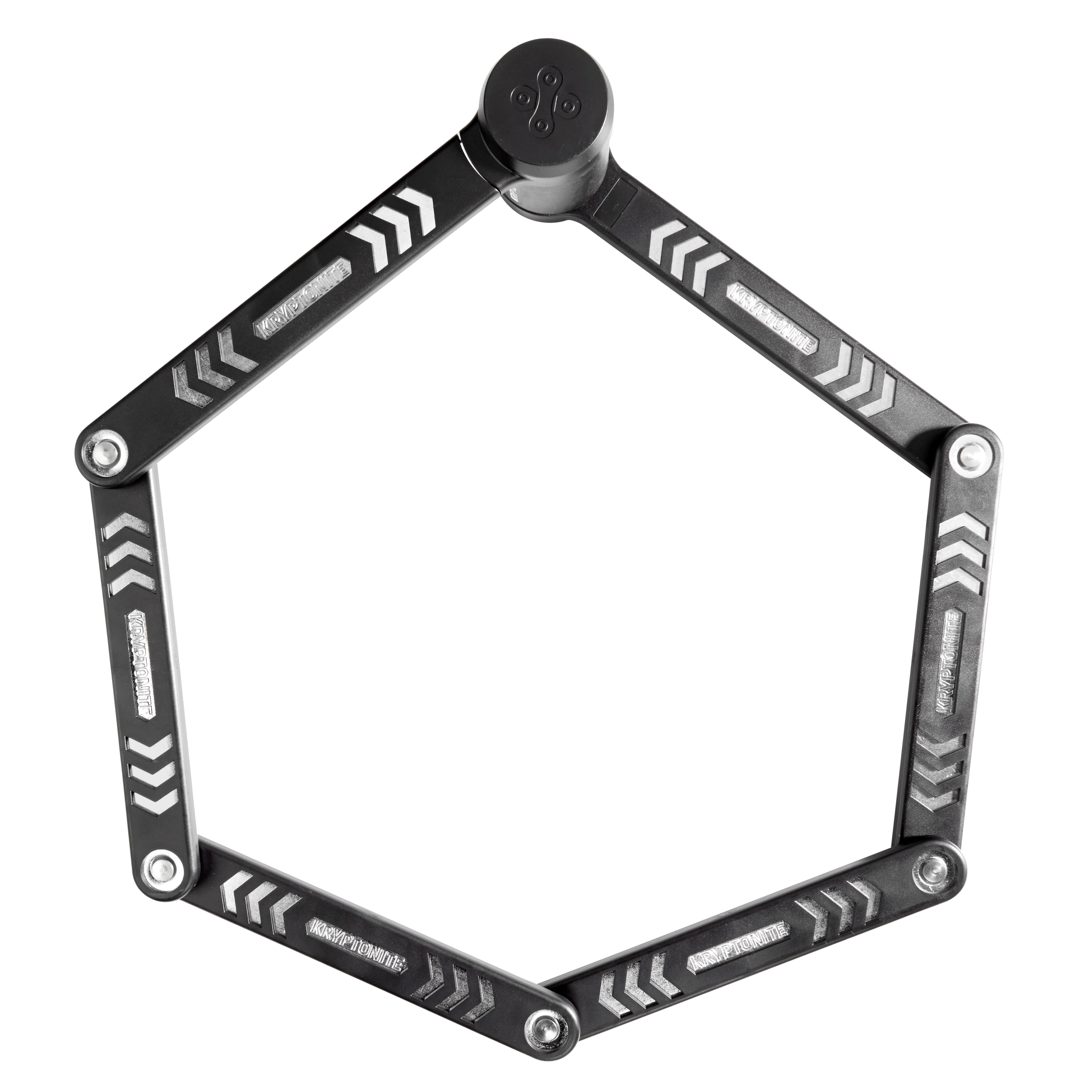
MSRP: $129.95
- Security Ratings: Sold Secure Bronze
- Weight: 2.65 lbs.
- Keys: 2 keys
- Thickness: 5mm
- Size: 40″
The Kryptolock 610 Folding lock features six 5mm hardened steel bars hinged together to create a flexible, secure lock that folds down into a small package for easier portability.
In terms of practicality, folding locks are by far the best bike locks you can get. This one comes with a Click Tight bracket that attaches to your bike and lets you easily carry the lock everywhere you go.
The Kryptolock 610 consists of six 5mm hardened steel bars and a heavy-duty lock resistant to tough attacks. The lock comes with 2 stainless steel keys and all the hardware you need to attach it to your bike and prevent rattling.
ABUS Bordo 6000/90 BK SH XPlus Folding Lock
Best Medium Security Folding Bike Lock
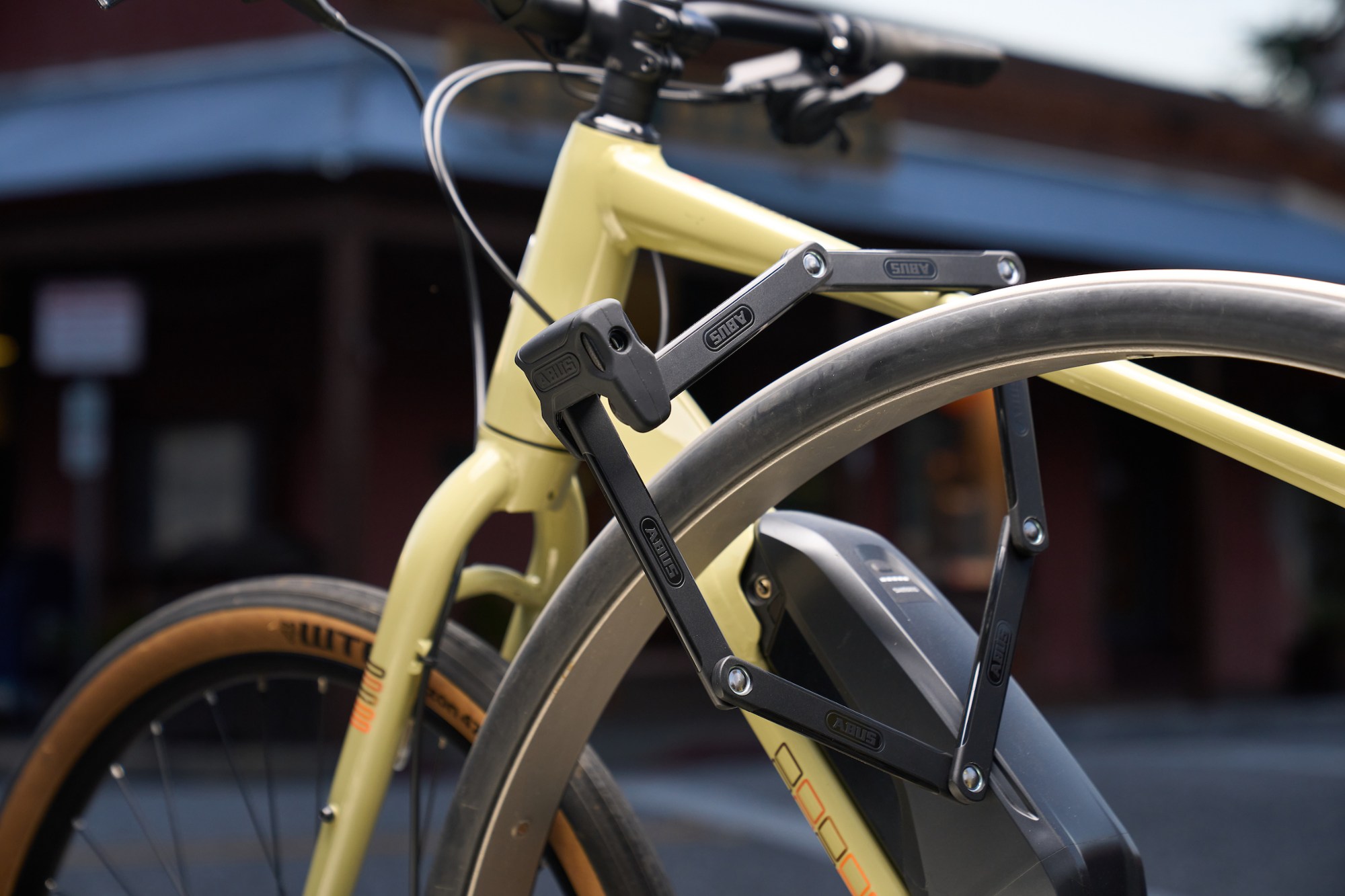
MSRP: $130
- Security Ratings: Sold Secure Bronze; Abus 10/15
- Weight: 2 lbs. 9.6 oz.
- Keys: 2 keys and a code card
- Thickness: 5mm
- Size: 35″
The Bordo 6000 is a relatively light and compact folding lock made by ABUS.
Weighing in at less than three pounds, the 6000 is relatively easy to carry, especially as it comes with a carrying bracket that you attach to your bike’s frame and that the lock clips into.
This lock is perfect when used on city streets where there’s enough lighting and traffic, and used on a bike that’s not overly flashy or expensive. That’s because it’s rated Sold Secure Bronze and Abus 10/15, which means it’s not a particularly heavy-duty lock. But that doesn’t mean it’s weak!
The six 5mm thick bars are connected with drill-resistant rivets and the XPlus lock cylinder offers protection against picking attacks.
Finally, the soft-touch coating on bars helps protect your bike’s finish, so you can feel free to use it even with your fancy bike.
ABUS uGrip Bordo 5700 Folding Lock
Best Budget Folding Lock
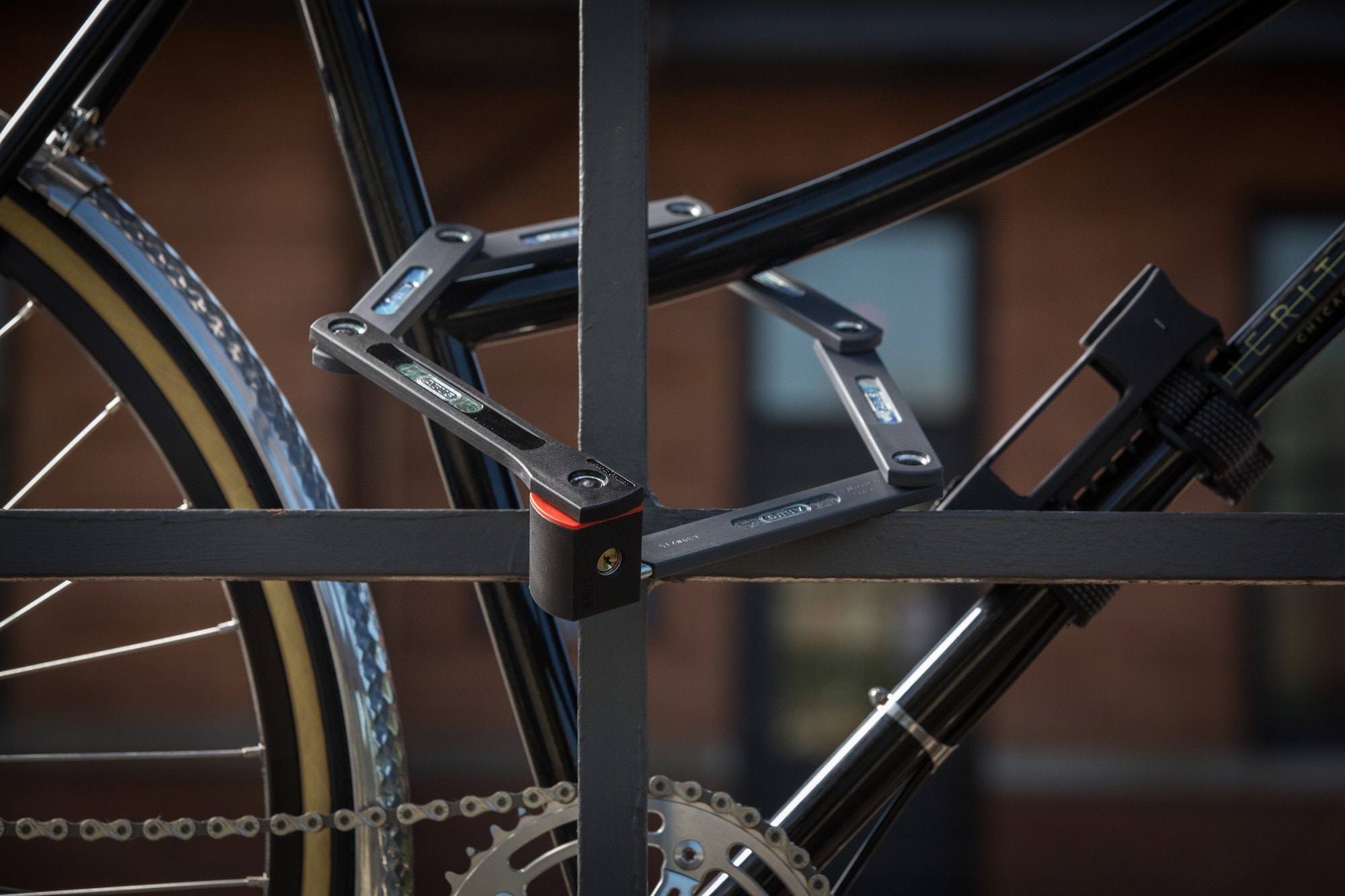
MSRP $85
- Security Ratings: Abus 7/15
- Weight: 1 lb. 15.7 oz.
- Keys: 2 keys
- Thickness: 5mm
- Size: 31.5″ or 39.5″
The Abus uGrip Bordo 5700 is a great solution for those who want a tough yet lightweight keyed folding lock for their bikes in safe neighborhoods of low to medium-risk areas.
It’s super compact, won’t scratch the bike’s frame, and comes with rattle-free mounting. The bike weighs just 1 lb. 15.7 oz., which is among the lightest on this list.
The Bordo 5700 consists of six 5mm thick hardened steel brackets connected with hardened steel rivets. The lock itself is resistant to picking and the rivets are resistant to drilling, so the only way thieves can get through it is to cut through the stainless steel brackets, which will take some time.
All in all, if you want a medium-priced bike lock with excellent security for quick to medium-long stops, the Abus uGrip Bordo 5700 is a safe choice.
Best Bike Locks with Alarm
Bike alarm systems are becoming more popular these days as technology gets smaller and cheaper. Some bike alarms come as part of a lock, whereas others are just an alarm and must be used in combination with a separate lock. Using just an alarm on its own is not adequate security as a thief could still escape with your bike physically before you have time to react.
Most alarm-enabled bike locks are weaker than traditional locks because the alarm should deter any extended attempt at theft. This means they offer a good lightweight alternative to heavy U-locks while still offering a high level of security.
Also, many bike alarms come with wireless or Bluetooth connectivity and will send an alert to your phone when they are tampered with. However, bike alarms should always be considered an additional level of security and are best when used in conjunction with a strong traditional lock.
Blackstone Anti-Theft 130 db Alarm U-Lock
Best U-Lock with an Alarm

MSRP: Check on Amazon
- Security Ratings: Not independently rated
- Weight: 4.31 lbs
- Keys: 3 keys
- Thickness: 14mm
- Size: 10″ x 3.3″
The Blackstone U-lock is available through Amazon and is a solid choice for medium-risk areas and applications, as it’s not independently rated.
However, the lock is made from hardened steel and features a combination of a U-lock and an additional steel cable, which means you can easily secure your frame and both front and rear wheels.
The best feature of this lock is the 130 db motion-activated alarm which will scare the thieves away and let you know that someone is tampering with your bike.
The 14mm steel shackle is as tough as nails and the 10″ x 3.3″ dimensions are among the largest on our list.
Because there are no independent security ratings for this alarm bike lock, we don’t recommend it for very expensive bikes, but it’s perfect for urban commuters.
G-Keni Bike Light Alarm
Best Anti-Theft Bike Alarm

MSRP: Check on Amazon
If you’re not sure whether or not your bike lock is going to be enough to protect your bike, we recommend using it together with an anti-temper bike alarm that will let you know if someone is messing around with your property.
The G-Keni Bike Light Alarm is a versatile and effective security solution for cyclists. Its loud 115 dB alarm, combined with three distinct flashing modes, makes it an excellent choice for deterring theft and enhancing visibility.
The water-resistant design and remote control operation up to 164 feet add convenience and reliability. This means you can ride it in the rain without any damage.
On top of that, it also includes a wireless electric horn, which not only secures the bike but also ensures the rider’s safety in traffic, and you can keep the key in your jersey pocket.
The USB rechargeable battery with a substantial standby time reduces the hassle of frequent charging, and the one-year quality guarantee further reinforces the product’s reliability, making it a worthwhile investment for regular cyclists seeking both security and functionality in a bike alarm system.
How to Choose a Bike Lock and Lock Your Bike Effectively
For many of us cyclists, our bikes are our most prized possessions. For others, they’re just tools for transport, exercise, or leisure. Either way, they are usually valuable, so we should do our best to keep them safe. To do so, you must have a high-quality lock and use good locking techniques.
While no lock is perfect, some are better than others, and some are almost useless. The more valuable your bike is and the higher the risk in your area, the better the lock should be.
This guide will discuss the different types of locks and their strengths and weaknesses, explain the different security standards, and teach you the most effective way to lock your bike to minimize the chance of theft.
Where and How to Lock Your Bike
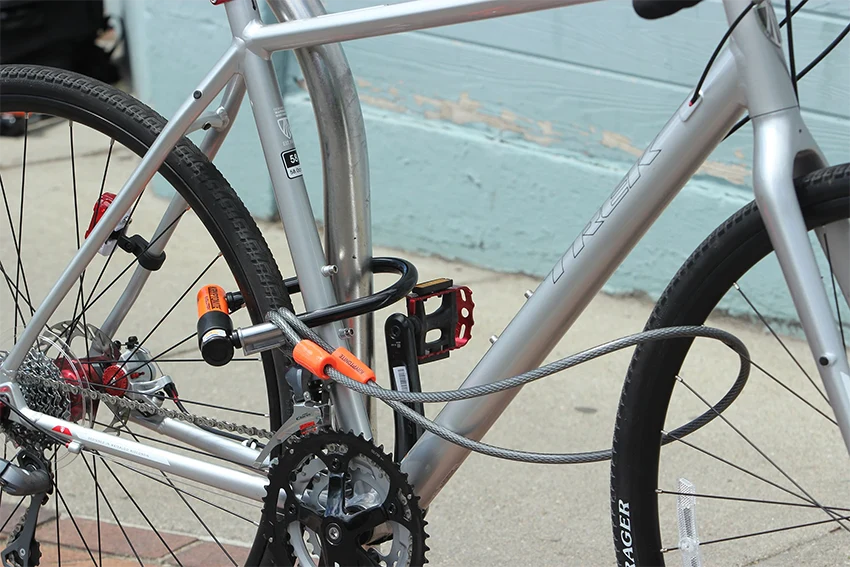
When locking your bike, make sure to lock it in a safe place and to lock the frame, rear wheel, and the front wheel, if possible.
Choosing where to lock your bike and what to lock it to is key to practicing good security. For example, locking up in a quiet lane with minimal foot traffic and poor lighting at night is a recipe for trouble.
Choose a place where other bikes are locked with heavy footfall, ideally in the shot of a CCTV camera (like in front of a building’s entrance). If you follow the advice in this section, your bike should be harder to steal than those you lock up beside, which reduces the appeal of stealing yours.
Ideally, you’d rotate the place where you lock your bike each day, especially if you have an expensive bike. Thieves may be keeping track of specific bikes and their owners’ habits in order to strike at an opportune time.
Finally, before you lock your bike, choose a fixed structure that can’t be tampered with, such as a bike rack, lamp post, or handrail. Avoid locking your bike to wooden posts or traffic signs, as these can be cut or tampered with to remove the bike.
Locking Technique
The goal of locking is to protect as many components as possible. The most effective way, once you’ve chosen the appropriate lock, is to minimize the space between the bike, the fixed point, and the lock, and keep the lock away from the ground where it’s easier to get leverage.
At a minimum, the lock should go around the frame and rear wheel. The rear wheel is more expensive than the front wheel. Some small U-locks may only fit around the frame, so a second lock can be used to secure the wheels or seatpost. Using a different type of lock as your second one means the thief will need two kinds of tools to steal your bike.
A safe yet time-consuming way of locking your bike is to remove the front wheel and lock it up with your frame and rear wheel with one lock. It’s hard to get leverage to cut or break the lock when the three parts are all tight together and the lock is positioned away from the ground. However, instead of removing the front wheel, you can loop a cable lock around it or use another lock to secure it.
To make lock picking harder for potential thieves, put the keyhole facing the ground and in a place that’s awkward to reach.
Types of Bike Locks and Their Strength and Weaknesses
There are four types of bike locks: chain, cable, folding, and U-locks. Each has its advantages and disadvantages. Each category has a wide range of options with different prices and security levels.
Later in the article, we’ll help you decide what level of security you need and how much to spend, but first, we’ll discuss the pros and cons of the four lock types.
U-Locks (D-Lock)
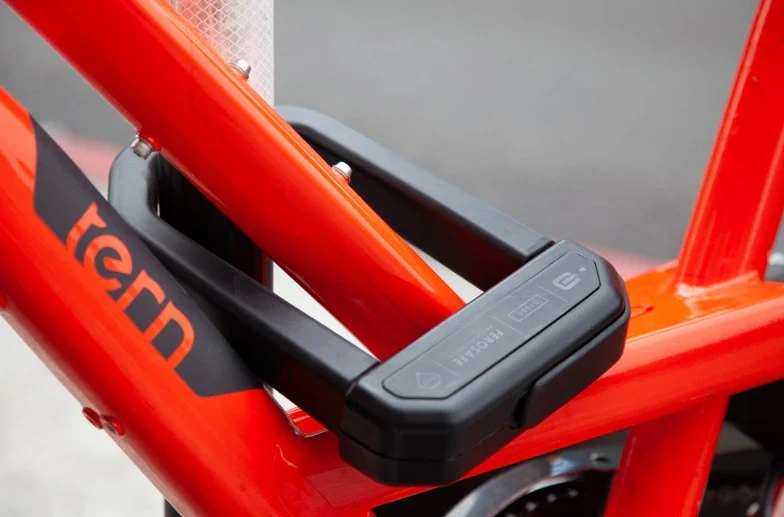
U-locks are the most common type, especially in cities, because they’re easy to transport and secure. They are typically made of hardened steel in a rigid ‘U’ shape and encased in plastic or rubber.
The locking mechanism is a straight bar that sits onto each point of the U and locks using a key or combination. This mechanism locks in one or two places, depending on the model. A dual-locking U-lock is more secure, as a thief must cut through two bars to release the bike. Most U-locks are keyed, but there are also combination options (Kryptonite Combo).
Smaller U-locks are more secure than larger ones of the same thickness, as, with less space, it’s harder for a thief to get leverage to break it open. The goal is to have as little space as possible between your bike, the locking point, and the lock. The trade-off of a smaller lock is that finding something to lock it to is trickier.
- Mid to high-security level
- Portable and easy to mount to your bike frame
- Lots of options and price points
- Resistant to most forms of theft
- Good ones are quite heavy
- Not flexible, limiting locking options
- Susceptible to hydraulic jacks (uncommon)
Chain Locks
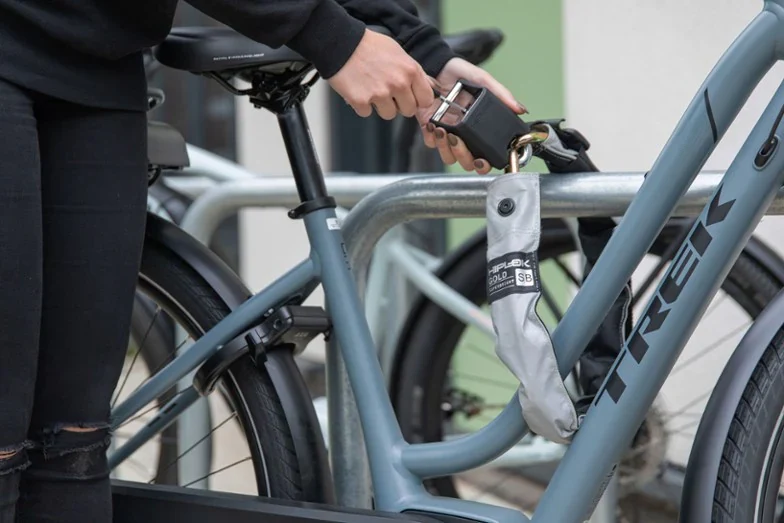
The most secure and versatile type of lock is a chain. Chain locks for bikes vary in thickness and length, but they’re typically made from a series of hardened steel links. The chain should then be housed in a flexible nylon sheath to protect your bike’s frame from scratches.
The shackle for a chain lock is a typical padlock or a discus padlock. This is often the weakest part of the system, so we recommend getting a thick, high-quality lock. The other potential vulnerability of chains is if the links are too big and allow a thief to get an instrument between them to exert pressure from the inside. Otherwise, a thick chain lock is very secure.
The advantage is the ability to lock your bike, multiple bikes, or your wheel and frame together thanks to the length and flexibility. These locks are best left in one place as they’re heavy and bulky, but they provide excellent ease of use.
- Very secure when used with a good padlock
- Flexible for locking to different objects
- Cheaper than U-locks
- Heavy
- Bulky and hard to carry
Folding Locks
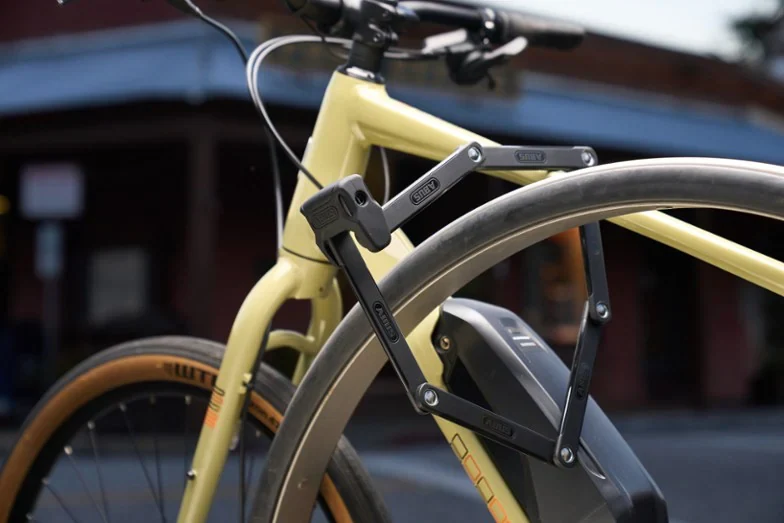
These are the least common type. They’re made up of a series of rectangular steel plates connected at the ends. The connections allow the plates to pivot independently of each other so they open into a wide loop and fold down into a neat package the width of one plate.
The steel plates are usually encased in soft rubber or plastic to avoid frame scratches, and the lock slides neatly into a mount attached to your frame or fits in a small backpack. The convenient compact design and flexibility of these locks is also their weakness. With each plate connected to the next by a rivet, there are several points of weakness that prepared thieves can exploit.
- Relatively lightweight
- Compact and easy to carry
- Flexibility to lock to any anchor
- Low to medium security
- Slightly more expensive
Cable Locks
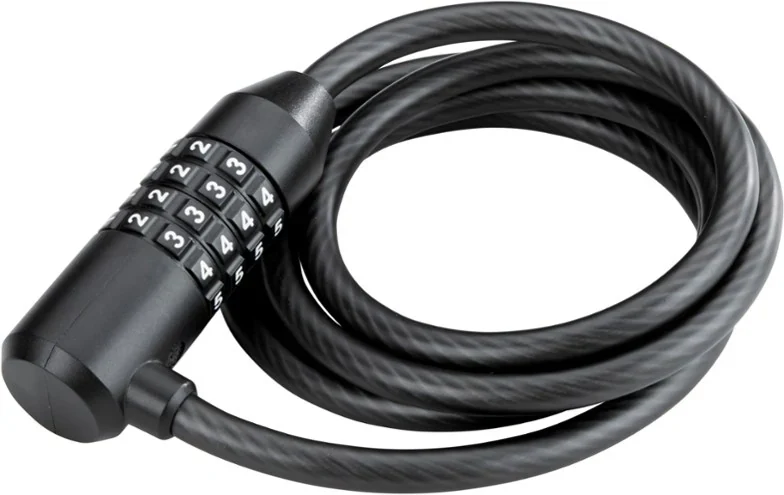
These locks are made with one steel wire or multiple thin steel wires coiled around each other and inside a soft plastic or rubber shell. They vary in length, thickness, and closure mechanism (key or combination).
Cables are the lowest-security locks, as most are very easy to cut with basic bolt cutters that fit in your pocket. They’re best used in conjunction with another lock in order to secure a component like a seatpost or a wheel.
As a primary lock, they’re only suitable for quickly popping into a shop in a low-risk area, such as a small town you pass through while out riding. In general, we’d avoid using them to lock your bike.
- Lightweight
- Easy to carry
- Cheap
- Flexible
- Minimal deterrent
- Unsuitable for the majority of scenarios
Other Locking Mechanisms and Components
If you’re a bike commuter living in a metropolitan area, avoid quick-release wheel skewers and seat posts, as they make an enticing snatch for an opportunist thief.
Your wheels or seat post and saddle could be taken in just a few seconds. At a minimum, use bolt-on wheels and seat post clamps. Locking wheel skewers are also a good investment if you live in a high-risk area.
Bike Lock Security Ratings
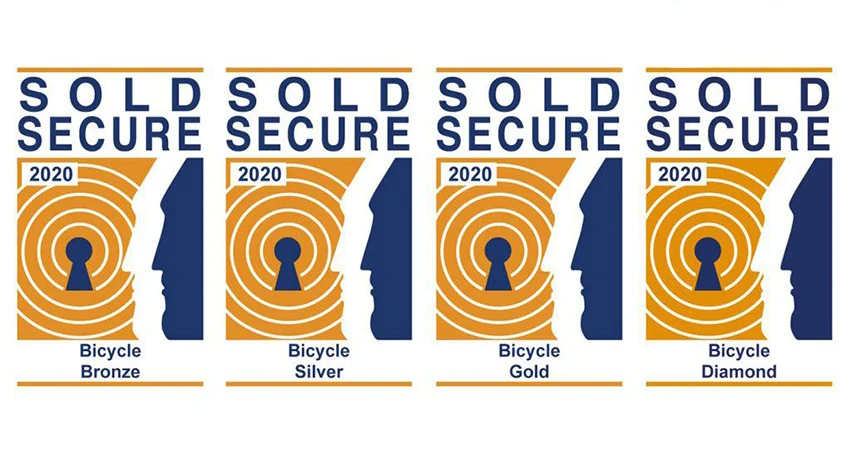
Sold Secure is one of the most reliable independent testers of bike locks with four safety tiers: Bronze, Silver, Gold and Diamond.
Bike lock manufacturers don’t use the same security ratings, and any company’s internal rating system should be taken with a pinch of salt unless it corresponds to independent testing.
An example of an independent third-party testing company is Sold Secure. This team assesses the effectiveness of locks and grades them on four levels: Bronze, Silver, Gold, and Diamond. You can search the site for a list of approved products.
All major brands submit their products for assessment by Sold Secure, such as Kryptonite, Hiplok, and ABUS.
Keyed vs. Combination Locks: Which Is Better?
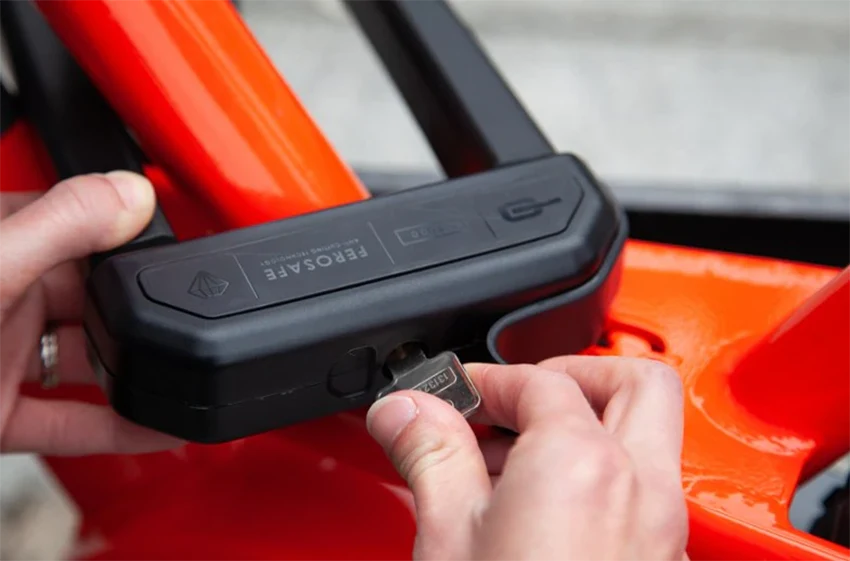
Both keyed and combination locks have advantages and disadvantages, but keyed locks are generally considered to be the more secure option.
Keyed and combination locks are the two main ways to close a bike lock. However, we’re sure smart locks with fingerprint, voice, or mobile unlocking will be widespread in the future. Some locks and e-bikes (Urtopia, Velotric) already allow fingerprint unlocking.
Keys are susceptible to human fallibility, as you could easily leave them on a bus or train or lose them during the day while your bike is locked up at the office. Thankfully, many higher-end brands offer key replacement programs in case you lose the two keys they provide with the lock. Register your lock with the manufacturer when you buy it to become part of this program.
The benefit of combination locks is that you only have to commit the code to memory once. Likewise, they don’t get rusty or fidgety to open over time like many keyed locks. Unfortunately, there aren’t many U-lock or folding locks with combination closures.
Assessing Risk Level
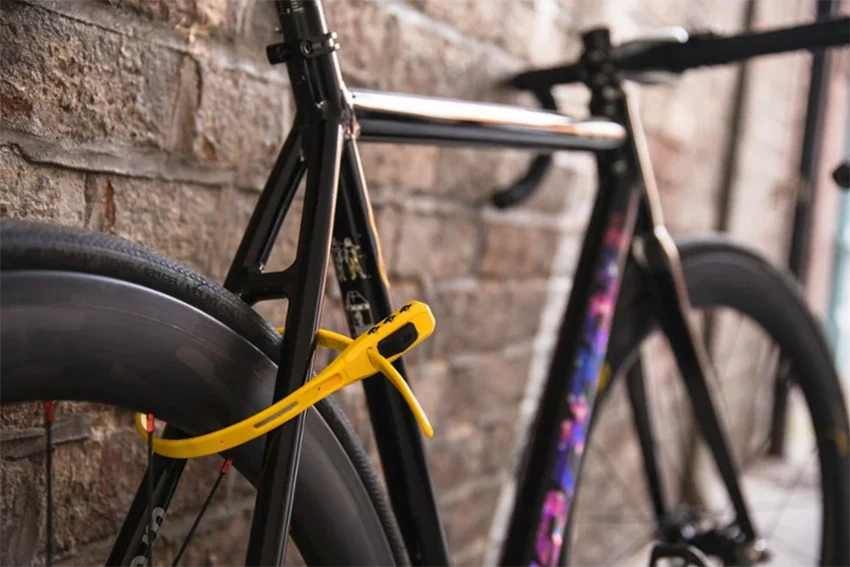
Use weak cable and tie locks only for quick in-and-out stops or as auxiliary locks to protect certain bike components.
The type of lock you choose should be based on the following factors:
- Level of risk in the areas where you lock your bike
- The type of theft you’re combating
- How much risk you’re willing to accept
- Value of the bike
- Convenience of the process (using two locks and securing multiple components takes time)
Avoid locking very valuable bikes in metropolitan areas for more than a few minutes, as a professional bike thief can always find a way through even the most expensive and robust locks. However, with the appropriate lock and locking technique, most bikes can be locked up safely for several hours, even in high crime areas.
Firstly, consider the area that you live in. In general, the larger the population, the higher the rate of bicycle theft. Therefore, most caution should be taken in cities. Suburbs and large towns typically require less aggressive security measures, and rural areas and small towns require minimal security and deterrence. If you live in a small town but regularly travel to the city with your bike, you should have a lock suitable for city living.
Next, consider how long you will leave your bike locked. The most risk is assumed when a bike is left overnight. The second most risky scenario is to leave your bike locked all day and into the dark hours. Finally, a period of a couple of hours and a very short period of under five minutes will require less security.
How Much to Spend on a Bike Lock?
The rule of thumb for deciding what to spend on a bike lock for city dwellers is roughly 10 percent of the bike’s cost. However, $200 is enough to buy locks with the highest security rating. If you have expensive wheels, seatposts, or saddle, you should consider a second lock to secure these parts.
If you live in a high-risk area, but your bike only costs $200 to $400, the percentage will be much higher than 10 percent (a $40 lock is 20 percent of the cost of a $200 bike).
The time and inconvenience of replacing a stolen bike is worth remembering, so using a cheap $20 cable lock on your $200 bike doesn’t make sense.
Transporting Your Bike Lock
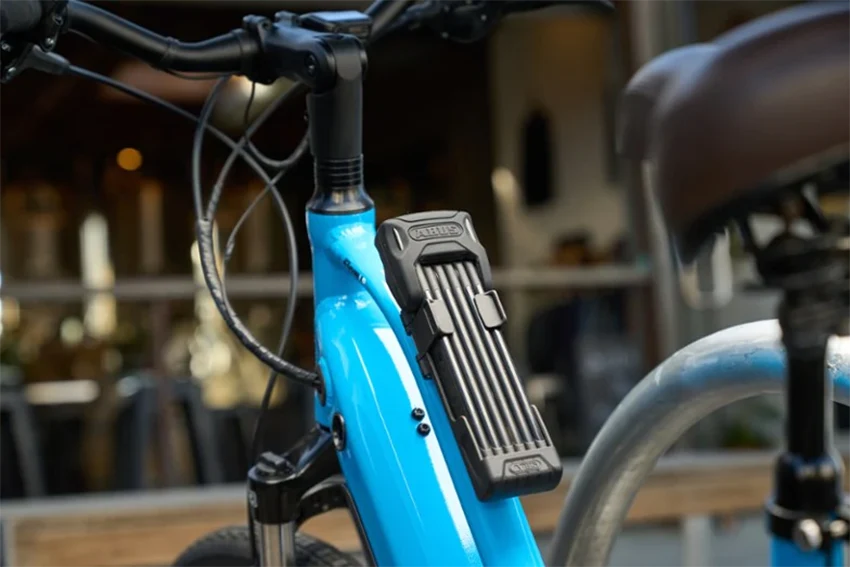
Folding bike locks are considered to be the easiest to transport as they come with a carrying bracket that you can attach to your bikes frame mounts.
The portability of a bike lock is an important factor in the buying decision. Folding locks and U-locks are more popular than higher-security chain locks because they are more portable.
Most U-locks and folding locks come with a mount that attaches to your bike frame. The lock should slide in and out of the mount without issue. Unfortunately, these mounts often take up the space of water bottle holders. If so, you can purchase an aftermarket lock mount for your bike frame.
If your bike has a rear rack, you can lock a U-lock to it, keeping it out of the way of the frame triangle. Cable locks can easily be wrapped around the rack or the frame for easy transportation. Alternatively, most of these locks will fit neatly in a cycling backpack.
Finally, you could choose a heavy-duty chain lock from the brand Hiplock, which sits conveniently around your waist while you commute.
Back-up: Bike Registry and GPS Trackers
If, despite your high-quality lock and good locking practice, your bike ends up getting stolen (unlikely), then you should have registered it online at a registry like BikeIndex.org. In that case, you can hope that a conscientious second-hand buyer will check the serial number before making the purchase and notify you through the registry that your stolen bike is up for sale.
Another excellent means of foiling a successful theft is to track your bike down and reclaim it (with the help of the police) using a GPS tracker. For example, a relatively cheap $25 Apple AirTag can be hidden on or in your bike and tracked using the company’s “Find My” app. Alternative GPS trackers are also available.


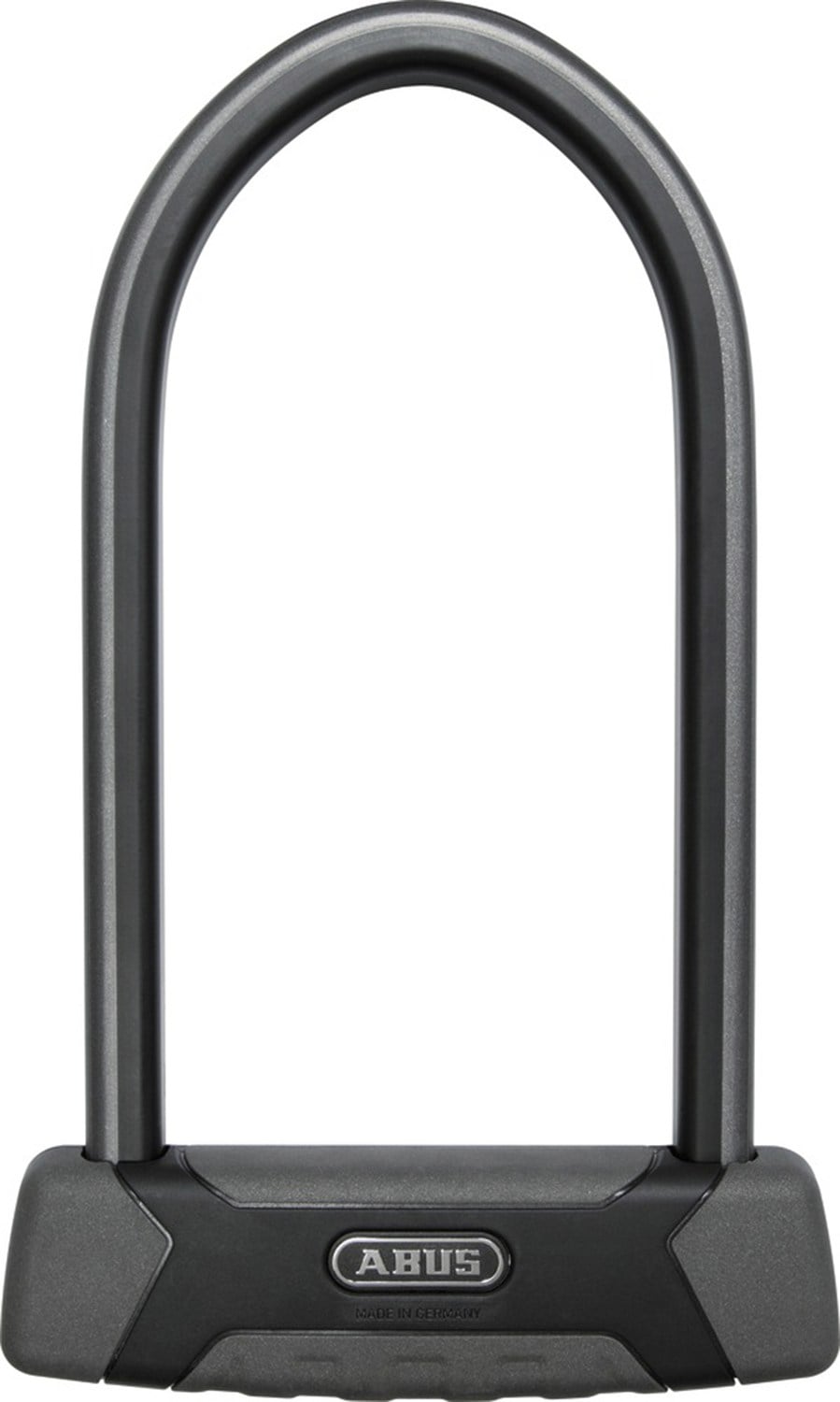



I think Kryptonite Keeper is a great chain bike locks. I’ve been able to use it to lock my bike in all kinds of weather, including blazing heat, rain, and wind. I was astounded by how consistently high-quality and dependable it is. The physical characteristics have not changed, and it still appears to be brand new.
Besides that, the 7 mm four-sided chain links are made with 3T manganese steel, known for their high-impact strength and abrasion-resistance features. Make your bike as safe as possible.